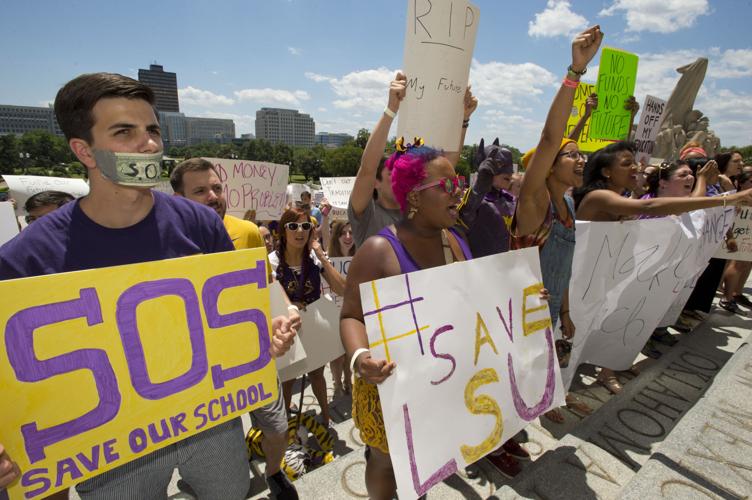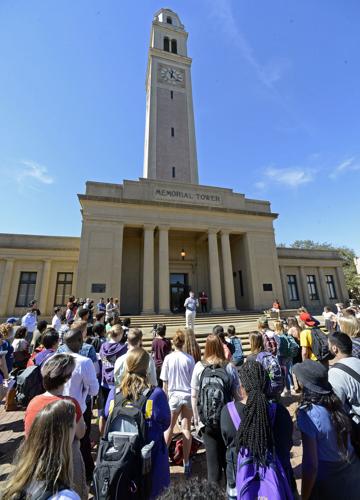LSU is still trying to fix the leaks that flood the basement of Middleton Library during routine rainstorms. But it provides top-shelf maintenance to the world-class, $3 million live tiger habitat that it built on campus for the school mascot.
The university trimmed at least a half-dozen programs and lost a raft of star faculty members in recent years as the state cut support to its flagship school by more than half. And yet LSU is spending almost $10 million to buy out the contract and fire one of the most successful head football coaches in school history, a man who won 77 percent of his games.
Les Miles is on the prowl for a new job.
The reason LSU can constantly tout new upgrades to Tiger Stadium while simultaneously struggling to provide enough dorm rooms for freshmen is that LSU is exceptional at fundraising for athletics and mediocre at raising dollars for academics.
In a typical year, LSU raises more money for athletic programs than it does for programs that benefit the classroom, according to tax filings reviewed by The Advocate.
One might expect that to be typical of all universities with major football programs. In fact, LSU is the outlier.
Of the nine schools in the Southeastern Conference with separate foundations for athletics and academics, LSU is the only one where athletic fundraising outpaces academic fundraising, according to the newspaper’s analysis of four years of tax documents.
"If you look at the buildings of LSU, all of the newest and most spectacular buildings belong to athletics," said Kevin Cope, president of the Faculty Senate. "Meanwhile, there are faculty, students and community members who work in buildings where the plumbing doesn't work, walls are falling down and the facilities are generally in a state of Third World disrepair."
When it rains outside Middleton Library on LSU’s campus, it rains inside, too.A group of emp…
Most of LSU's fundraising efforts benefit one of two foundations.
The Tiger Athletic Foundation raises money for sports infrastructure like stadium expansions, the recent $2.5 million renovation to the weight room and the maintenance of Mike the Tiger's elaborate habitat. It also helps fund sports scholarships and supplements coaches' salaries, which, in football, can run into seven figures.
The LSU Foundation, meanwhile, supports the university's academic and research missions: providing endowed professorships that attract high-profile faculty, building new classrooms and laboratories and providing scholarships and other student support programs.
In a typical year, TAF receives about $45 million in donations that serve the university's intercollegiate athletic programs, compared to about $41 million for the LSU Foundation. The university’s other main sources of revenue – principally tuition and state support – amount to around $500 million a year for operations, so the foundation money is critical.

Not only do LSU’s peer schools take in more money for academics than for sports — it isn't even close for most of them. The University of Florida, Mississippi State, the University of Georgia, Auburn and the University of South Carolina all raise more than twice as much money for the classroom as for the locker room.
The University of Florida's Gator Boosters athletic foundation resembles TAF, bringing in about $45 million a year. But the University of Florida Foundation, by comparison, brings in roughly $110 million a year for academics – nearly three times what its counterpart at LSU raises.
The same pattern holds at some other non-SEC schools with major football programs. Florida State University, the 2013 national champ, has received an average of $53 million in gifts for academic programs in recent years versus an average of $21 million for athletics. Clemson, the No. 3-ranked college football program, raises roughly 30 percent more for academics than it does for athletic programs.
Notably, the University of Alabama -- LSU's archrival -- does not disclose financial information for any university or athletic fundraising. Nonprofit organizations like foundations are generally required to fill out tax forms which disclose contributions, assets and salaries. But Alabama does not do so, citing its affiliation with a governmental entity. The school also refused to comply with a public-records request and did not respond to questions from The Advocate.
Three other SEC schools -- the University of Missouri, Vanderbilt University and the University of Tennessee -- do not separate academic and athletic giving. Instead, the schools, like many around the nation, have a single university foundation that raises money for both purposes. The University of Kentucky has no foundation at all.
"The No. 1 thing that supports TAF is the passion of the LSU fans," said Rick Perry, the foundation's president. "They absolutely love the program. They want to support it. They want to see it be successful."
But LSU officials say it’s not that donors care more about athletics than academics. Instead, they say, the problem is that until recently, LSU hadn't put the muscle into academic fundraising that other schools have done for years.
LSU President F. King Alexander said the university is building momentum around academic fundraising. The three past years were among the strongest fundraising years in history for LSU, bringing in some of the largest pledges in school history, such as a $12 million gift to the Ogden Honors College, named for donor Roger Ogden. Another huge pledge was a $40 million estate donation, to be realized upon the anonymous donor's death. It will include $20 million for the College of Engineering and $20 million for sports.
Still, Alexander said, private donations are more important than ever to LSU, since the school has endured almost a decade of declining support from state taxpayers.
He acknowledged that LSU has a lot of catching up to do. "We're not where we want to be," he said.
Since the late 1800s, LSU’s status within Louisiana has been secure. It’s the unchallenged b…
Academic fundraising lags
While taxes and tuition dollars are the primary funding sources for public universities, schools increasingly rely on private donations for the extra edge that schools need to be competitive.
It’s working on the athletic side for LSU: TAF's close support is a key to the Tigers’ athletics success.
"In order to get high-quality athletes, you need to have a really great weight room and all kinds of facilities, so they want to come there," said John Maxwell Hamilton, a former LSU provost and current faculty member. "And the way you attract outstanding faculty who are going to produce outstanding students and give you victory in the classroom is by giving them the extra things that make them want to come to LSU."
Unfortunately, LSU isn’t faring so well in that latter competition. For years, university officials have lamented LSU’s low rank in academic fundraising in measures like the overall percentage of alumni who donate -- 6 percent for LSU, compared to 20 percent for the University of Arkansas, for instance. A smaller share of LSU alumni contribute to academics than at any other SEC school.

It’s not just how many alumni give, but how much they give. The LSU Foundation also lags its peers in annual academic contributions, where schools like Auburn, Georgia and Arkansas take in roughly 30 percent more per year. Florida and Texas A&M annually bring in more than twice as much for academics as LSU.
Hamilton, who also was the founding dean of the Manship School of Mass Communications, said he'd prefer to see a stronger emphasis on academic fundraising at LSU.
"I appreciate the support that the athletic program has, and it does create a lot of school spirit, but in the end, academics is more important," he said. "That has to be aligned in a way that reflects why we have the university in the first place, especially if we really care about our young people in this state."
LSU’s tepid history of academic fundraising is one reason its endowment pales next to those of its SEC peers. The LSU Foundation has an endowment of $382 million, or $14,100 per student. The SEC median is an endowment of $27,200 per student.
Ann Kaplan, director of the Council for Aid to Education, a national nonprofit that measures university fundraising, said endowments are among the strongest measurements of a foundation because they provide dollars in perpetuity for faculty and students. Typically, an endowment is invested; the interest is spent, but the principal is never used, ensuring a continued stream of funding.
LSU’s most recent major fundraising campaign, called Forever LSU, was rolled out in 2006 as an endowment campaign with a $750 million goal.
"The original vision for Forever LSU was (to make it) 100 percent endowment," Stephen Moret, president of the LSU Foundation, said earlier this year. "That changed quickly when people realized what the donor interests were. People give to what they're passionate about."
Ultimately, Forever LSU reached its goal only by moving the goalposts, as it were: The university wound up including in its count other kinds of donations, almost half of which were designated for athletics.
In total, Forever LSU raised $764 million, $354 million of which was for sports. Only $123 million was raised toward the endowment. The rest was in the form of other gifts and infrastructure for LSU.
Kaplan and other experts consider donations for new infrastructure "low-hanging fruit" for universities, because donors usually get their name on a building.
For years, LSU has paled in comparison to its regional peers around the South in fundraising…
LSU is currently planning for its next major fundraising campaign, which will likely have a goal of at least $1.3 billion. Athletics will be a part of the campaign, but this time, Alexander said, "I'd like to see a much more appropriate balance."
He didn't specify what percentage would be targeted for athletics compared to academics.
"We just need to ramp up on the academic side," he said.
Athletic donations
While LSU is playing catch-up on academic philanthropy, other schools are trying to match TAF's success in the world of athletic fundraising.
A sign of the high profile of TAF on the LSU campus is its administrative payroll. Former TAF President Maj. Gen. Ron Richard earned $362,000 a year. The salary put him in line with the university's provost, the second-highest-paid position behind the president, outside of athletic staff.
Perry's most recent salary was not reflected in the most recent tax forms. TAF's president was also among the highest-paid SEC athletic foundation CEOs.
"LSU really has one of the premier athletic foundations in America," Moret said in a recent interview. "What we're trying to achieve for academics is what TAF has already achieved for athletics."
Traditionally, athletic donations involve a carrot that academic donations don't -- season tickets. At schools with big-time football teams, including every SEC school, tickets are often allocated with a point system, and more generous donations allow for better seats and increased opportunities to attend away games and championship games.
Suite tickets in Tiger Stadium can require a donation history of at least $35,000. But Perry, TAF's leader, said TAF receives upward of $12 million a year in donations unrelated to tickets that are typically earmarked for scholarships.
LSU's leadership in athletic fundraising is not completely coincidental. Conventional wisdom would suggest that money spent to purchase college football tickets would not be considered a charitable donation. But in 1986, LSU and the University of Texas successfully lobbied Congress to allow their ticket holders to deduct 80 percent of their costs.
At the time, the two schools were the only ones with such a benefit, but other school programs soon followed, setting off an arms race in the world of athletic spending.
Officials also note that this donation system, with the assistance of TAF, has allowed LSU's athletic program to be one of the few in the nation that doesn't cost the university money. Instead, TAF sends a modest sum to the university each year to support academic programs.
TAF typically gives about $300,000 a year to LSU for scholarships and teaching awards, according to audits.
Competition in dollars?
Jeff Smith, a professor at the University of South Carolina Upstate who has written extensively about funding for college athletics, is not surprised that LSU's donors would invest more into sports.
"LSU is not on many lists of excellence. People get mad when you use the word ‘average,’ but LSU is academically a very ‘average’ institution," he said. "LSU is known for its athletics."
And when it comes to shaking the cup, Smith said it can be a zero-sum game, with academics and athletics fighting over the same pool of donors.
"They do compete," he said. "Alumni, when they get calls about academic initiatives and giving to foundations, they can say, 'Well, I've already given this year when I gave to the athletic foundation.’ "
In past years, according to Moret, there may have been competition for dollars because the organizations were not collaborating well. But both Moret and Perry said the organizations now are working more closely with each other.
Perry also noted that 40 percent of TAF donors are not LSU graduates, meaning that sports may be their primary connection to the university. He said there's the potential through athletics to reach a wider range of people, with the hope of later bringing them into the fold for academic giving.
"Donors are going to give where they want to give," he said. "It doesn't matter where people give. If they're giving to the university and enjoying the experience of helping, then they'll give in many different ways."
Nicholls State University’s sports teams cost the school more money each year than the unive…

























